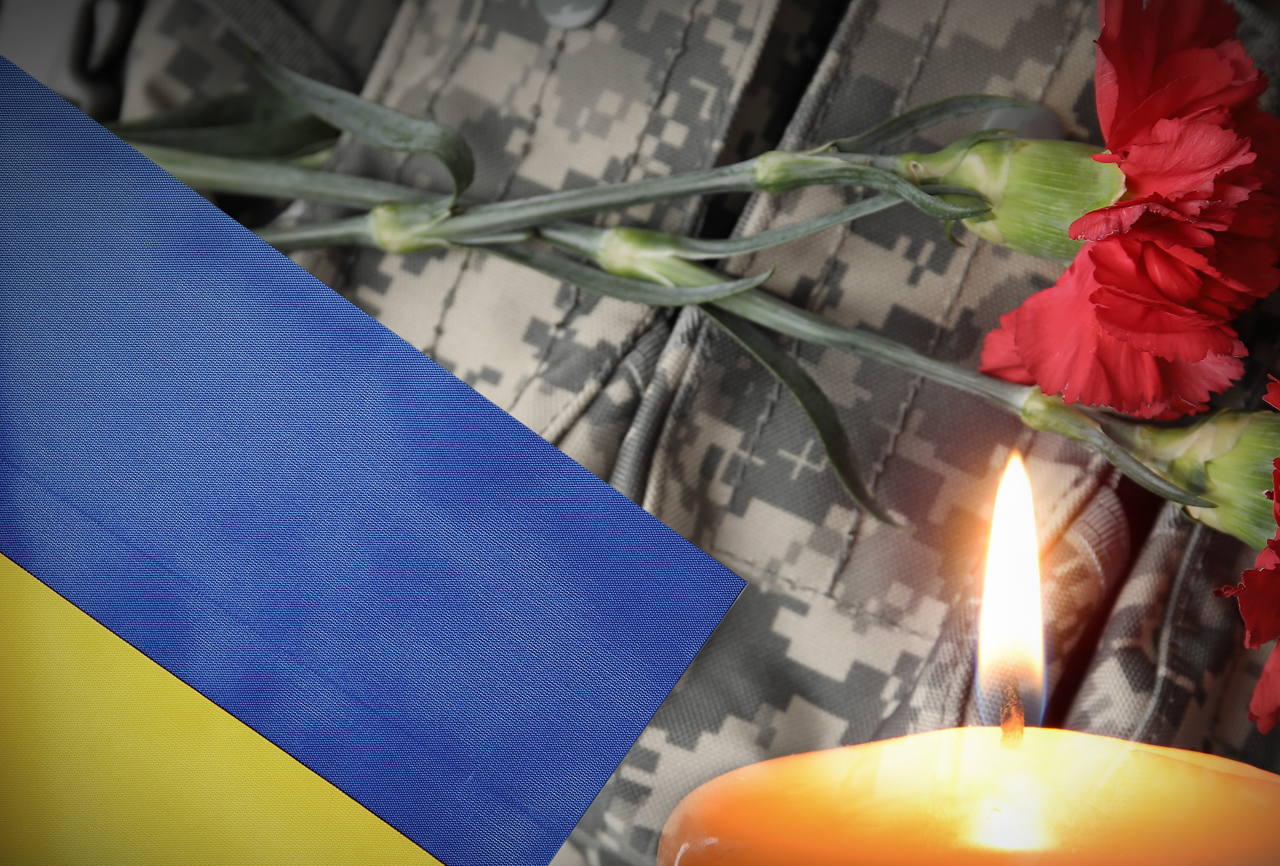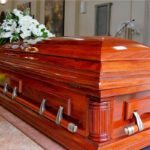
The question is, how to bury the dead when they are all around you?
When there are deaths every day across a country in the middle of a full-scale invasion. When villages are being struck, cities are being struck, suburbs are being struck, and theaters and shopping centers and schools and even maternity wards and cancer centers are being struck too. How to bury the dead?
“For the naturally empathetic and compassionate members of the deathcare profession, watching the growing death toll — especially among innocent Ukrainians — must be excruciating,” notes a post on Connecting Directors, the funeral industry news site. “Despite the inherent danger, though, Ukrainian families are still providing proper funeral rites and burials.”
As the world has watched this war, Ukrainians have tried courageously to hold tight to ceremonies, processes, and moments that allow for grief. Moments that allow space for spouses to cry, children to lay down wreaths of flowers, and mothers and fathers and family members to carry the coffins to the grave. Even in the besieged southern city of Mariupol, which has been decimated by Russian shelling and where thousands have been killed, the attempt to wrap the dead in blankets and place them in mass graves is still an effort to provide a grave. To create some sort of hallowed ground and cemetery out of the circumstances, as crude as it may be. Even if there is no coffin, and the grave is a hand-dug hole in the vegetable garden in the backyard.
This, in fact, is the story of Iryna Kostenko, a mother in the Kyiv area who lost her only son, Alexey, on March 10th. “They were in jeeps, with guns, they killed him and fled,” Iryna told the BBC. Having little, and no one to help her, she did what she could to create a proper sendoff for her 27-year-old child. Iryna put his body in a wheelbarrow and brought him home. She dug the grave herself, and having no coffin, rolled him in a carpet then mounded earth back on top. Another carpet, a very pretty one with large dark magenta and blue flower patterns lies on top of the burial site. And there is a wooden pallet on top of that to hold everything down. In these times, and in this place, this simple funeral stands heroic, a testament to our desire to create a ritual and create a peace out of even the toughest of times.
But in a country at war, sometimes the funerals happen in solitude because they have to happen this way. And the family of the deceased is still cut off from the dead by the rough battle lines of war. Such was the case for 21-year-old Dmytro Kotenko, who died near the southern city of Kherson on the third day of the Russian invasion.
“There was no family around Dmytro Kotenko when they put him in the ground,” reads another BBC news story. “His parents did not hear the gunshots that rang out over his grave. They did not hear the sound of the ribbon tied to the wooden cross above him as it fluttered in the wind. They did not see the rough earth that first landed on his coffin and they did not lay a flower over him when he was completely covered by the earth…Most likely, Kotenko’s parents did not know their son was being buried that day in the Lychakiv Cemetery in Lviv. They were 600 miles away, with his two younger brothers, near the eastern city of Sumy, which was being so heavily shelled by Russian forces that it was cut off from the outside world.”
So, Kotenko’s friend, Vadym Yarovenko, traveled alone from his base to the Saints Peter and Paul Garrison Church in Lviv. And Yarovenko stood alone on one side of the nave, under its vaulted ceiling painted with saints, as smoke from burning incense drifted over the priests and mourners. “We will be honouring the fallen all our lives,” said the church’s Father Vsevolod, standing in front of the portraits of the dead. The church was built in the 1600s. Father Vsevolod told the BBC, “We are part of this city’s mission to bury army men and women with honours, so their acts of bravery are never forgotten.”
Before the invasion, the church held a funeral for a soldier once or twice a month, now it is burying two or three people a day. And the Lyachakiv Cemetery, where Kotenko’s body was buried, has become the final resting ground for those soldiers whose families are unable to take them home or cannot be located. It is often local soldiers carrying out the ceremonial duties. The soldiers of this war are buried among the dead from World War I, World War II, and the war with Russian-backed forces in Donbas in eastern Ukraine that began in 2014. Every funeral is a military funeral. CNN’s Jake Tapper recently attended one of them.
“Today had to break ground in a fresh field to make room for the new war dead, repurposing the cemeteries adjacent World War II memorial to find space for the influx,” Tapper reported. The day he visited the funerals were for a Ukrainian army sergeant, 43, and a private, 33, killed on April 1st. Both men had been called to service after the Russians invaded. “Every day we have two to three burials here in Lviv,” a spokesperson for the city’s mayor’s office told Tapper. “That is the price for our victory. Heroes never die, we bury the body but the glory of these people will live forever, in our hearts and in our history.”
Funeral ceremonies here have become a way to remember the dead, but also an instant part of history. There is no separation between the current moment and the eternal note of this struggle.
In Starychi, Ukraine, a village of 3,400 not far from the Polish border, there is the story of this somber funeral procession, reported by the LA Times:
“They hoisted the coffins into a pair of beat-up Humvees, then began the slow trek from the church to the village cemetery, past a muddy stream, railroad tracks, and a stretch of woods. A couple of soldiers at the head of the procession held up a wooden cross and a Ukrainian flag. A man in a dark coat carried a picture of one of the fallen. A military brass band, its members decked out in camouflage gear, played dirges as the cortege moved forward under overcast skies. Residents came out of their homes to line the roadway and pay their respects. Many made the sign of the cross. Some knelt. A few cried.”
Their destination was the Church of the Nativity of the Blessed Virgin Mary in Starychi. The fallen were Roman Ruck, 48, who left a wife and two sons, and Mykola Mykytyuk, 54, survived by a wife and four daughters. These men were among at least 40 Ukrainian service members killed when Russian cruise missiles hit a nearby military training compound known as the International Peacekeeping and Security Center. The strike happened during the predawn hours, on a Sunday morning in mid-March.
The plots in Starychi are “side by side in an empty stretch of land adjoining the town cemetery. There is some talk of a monument honoring the dead,” the LA Times article reported. “The bare field has ample space for more victims in a war that shows no signs of concluding anytime soon.”
How many have died since the war began? It is difficult to say for sure, as tallies of the dead have been disputed by both Ukrainian and Russian sources. A Wikipedia page on the Russian invasion of Ukraine mentions an estimate by the Ukrainian government that around 27,800 civilians have been killed and between 2,500 and 3,000 Ukrainian soldiers. According to the Russian government, as cited on the Wikipedia page, there have been 1,351 Russian Armed Forces killed. The US government has estimated the number of Russian forces killed to be more than 10,000, whereas the Ukrainian government has estimated those losses to be more than 20,000.
And what about the deaths that would have come anyway, but the war has hastened? Or the deaths that would have come anyway but the war has made more tragic, or more lonely? A child sick with cancer who can no longer receive the appropriate treatment, or an older person whose nursing home was bombed and no longer has a safe place to be. Or the people who will die many months or years later, in ways researchers and sociologists still don’t quite understand, because their homeland and way of life have been disrupted and destroyed, their rock and centering devices crushed, the carpet of stability pulled out from under them.
As the Connecting Directors article noted, at least among the Ukrainian Orthodox tradition, a proper funeral ceremony involves four distinct events, and certainly not all of them are being carried out here in wartime. There is a prayer service on the eve of the funeral, a funeral mass, burial, and a memorial lunch where loved ones can express condolences to the family. During the funeral service, the casket is left open to allow the celebrant to bless the body with holy water and for attendees to offer a final farewell.
Korban Funeral Chapel, in Winnipeg, Canada, says that “Family members and friends come to say their final goodbyes alongside an open casket on…three special days. They may leave small gifts inside of the casket when they come to visit like coins, baked goods, and other small mementos. Family and friends can bring flowers to the wake, but they should only bring an even number of flowers. This sets the funeral apart from other occasions when Ukrainians expect well-wishers to give an odd number of flowers.”
“Many people believe that the body should never be left alone in the dark,” Korban Funeral continues. “This is why they typically plan to have visitors come throughout the night.”
And one must wonder too about the Russian dead, how are they being buried or remembered. As the Connecting Directors post noted, “Funeral traditions for Russians practicing the Orthodox faith are similar to those of the Ukrainian Orthodox — after all, the religion was one and the same for 300 years, until 2019, when the Ukrainian Orthodox Church broke off from the Russian Orthodox Church over jurisdictional disputes.”
A photo popularly shared from early in the war showed the body of a Russian soldier on a roadside covered in snow. What were this soldier’s family members told, if anything, about his death? And how was he remembered, if at all? It has been reported that bodies of dead Russian soldiers lie abandoned across Ukraine.
There are many stories from the war that are just too terrible to repeat. It is the job of people like the war photographer James Nachtwey to capture them. He was recently in the Ukrainian village of Bucha, where numerous atrocities occurred against civilians. And he has photographed conflicts, war zones, and humanitarian crises around the world.
“Why photograph war?” Nachtwey says, in a documentary about his life. “Is it possible to put an end to a form of human behavior which has existed throughout history by means of photography? The proportions of that notion seem ridiculously out of balance, yet that very idea has motivated me. For me, the strength of photography lies in its ability to evoke a sense of humanity. If war is a sense to negate humanity, then photography can be perceived as the opposite of war, and if it is used well it can be a powerful ingredient to the antidote to war.”
“In a way,” says Nachtwey, “if an individual assumes the risk of placing himself in the middle of a war in order to communicate to the rest of the world what is happening he is trying to negotiate for peace.”









